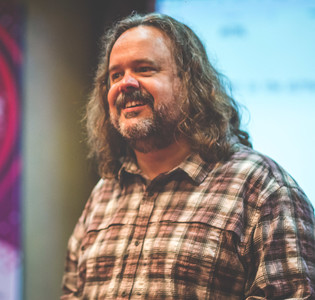
“Once again Saltmarch has knocked it out of the park with interesting speakers, engaging content and challenging ideas. No jetlag fog at all, which counts for how interesting the whole thing was."
Cybersecurity Lead, PwC

In his latest talk at Great International Developer Summit, Duncan Ng, Director of Solutions Engineering at Vultr, shifted the spotlight from the garden-variety x86 processors to the high-stakes arena of GPUs. Ng's discourse ranged from Charles Babbage's rudimentary computational machines to the well-known x86 architecture. But the real meat of his presentation? The game-changing role of GPUs in driving forward Moore's Law—the principle that computing power doubles roughly every two years.
Ng minced no words when addressing the difficulty developers face when trying to get their hands on GPUs. “While x86 processors are the bread and butter of the computing world, GPUs are the rare truffles,” he asserted. The demand for these computational workhorses greatly exceeds supply, throwing a wrench into the gears of innovation. To translate this into real-world scenarios: you're a developer who needs a GPU to bring an idea to life. Be prepared to jump through hoops of fire, get the budget approved, and then wait. And wait some more. This lag in resource acquisition adds friction to the entire development process, from conception to deployment.
“This scarcity is not just a minor inconvenience; it's a significant hurdle for innovation. For a team of developers, the procurement of GPUs becomes a complex and costly affair.”
Enter the breakthrough idea of fractionalizing GPUs, a solution that could dramatically shake up the innovation equation. Ng breaks it down: instead of hogging an entire GPU for a single developer or task, why not divvy it up? Perhaps down to a sliver—a tenth of a unit. The financial implications are seismic. Your infrastructure costs could plummet from eating half your revenue to a manageable 5-10%.
“Fractionalizing GPUs dramatically changes the economics of development. This approach not only makes the business more viable but also speeds up the time-to-market for new products and services.”
This isn't just about saving money. The fractionalization concept slashes time off every step of the development cycle—build, test, deploy. What used to be a months-long odyssey could be scaled down to a sprint. "This efficiency isn't just a cost-cutting tactic," Ng emphasized. "It's a catalyst for rapid innovation. It allows teams to iterate faster, validate their models more effectively, and push their products out the door at an unprecedented speed."
“What used to take months can now be accomplished in minutes. This isn't just about cutting costs; it's about enabling rapid innovation.”
But Ng doesn't stop there. His vision takes a global scale—unleashing the power of international collaboration. Imagine a world where GPU access is no longer a bottleneck. Developers across continents can pool their resources, blending diverse skill sets into more robust solutions. Financial trading algorithms can take shape through collective efforts from Bangalore, Singapore, and London, each contributing unique market expertise.
“With easier access to GPUs, teams from different parts of the world can contribute their unique skills and perspectives. This kind of cross-pollination of ideas leads to more robust and innovative solutions.”
Vultr, where Ng serves as Director of Solutions Engineering, is already putting these ideas into practice by providing fractional GPU resources across a global network of data centers. And it's not just about the hardware. Vultr's platform supports an extensive array of tools and languages, making it easier for developers to move seamlessly from one stage of development to another, without the cumbersome need for code refactoring. It's this blend of flexibility and utility that keeps the innovation engine humming along at full tilt.
In wrapping up his talk, Duncan Ng urged us to recalibrate our thoughts on machine learning and AI development. By democratizing GPU access through fractionalization and global collaboration, we can sidestep the constraints of resource scarcity and propel ourselves into a new age of accelerated innovation in machine learning and artificial intelligence.
Watch the full video of the talk, here.
Have questions or comments about this article? Reach out to us here.
Banner Image Credits: Duncan Ng at Great International Developer Summit

“Once again Saltmarch has knocked it out of the park with interesting speakers, engaging content and challenging ideas. No jetlag fog at all, which counts for how interesting the whole thing was."
Cybersecurity Lead, PwC

“Very much looking forward to next year. I will be keeping my eye out for the date so I can make sure I lock it in my calendar."
Software Engineering Specialist, Intuit

“Best conference I have ever been to with lots of insights and information on next generation technologies and those that are the need of the hour."
Software Architect, GroupOn

“Happy to meet everyone who came from near and far. Glad to know you've discovered some great lessons here, and glad you joined us for all the discoveries great and small."
Web Architect & Principal Engineer, Scott Davis

“Wonderful set of conferences, well organized, fantastic speakers, and an amazingly interactive set of audience. Thanks for having me at the events!"
Founder of Agile Developer Inc., Dr. Venkat Subramaniam

“What a buzz! The events have been instrumental in bringing the whole software community together. There has been something for everyone from developers to architects to business to vendors. Thanks everyone!"
Voltaire Yap, Global Events Manager, Oracle Corp.